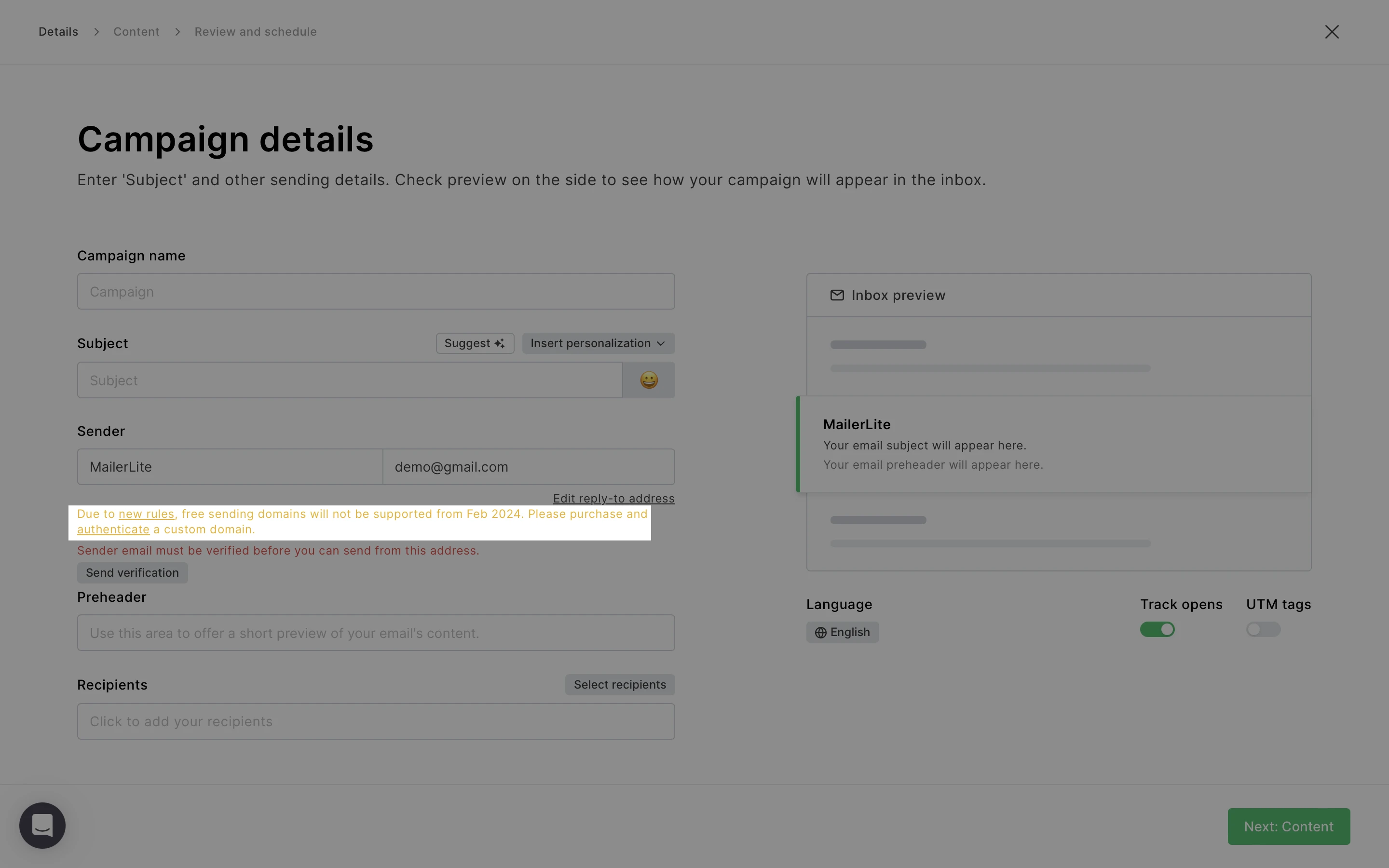Can I use a Gmail address to send campaigns with Mailerlite?
Google and Yahoo have announced new rules for bulk email senders effective beginning February 2024. The use of public domains (such as Gmail) as a sender address is not recommended. According to Google, it may negatively impact your ability to reach your subscribers' inboxes.
With these new rules, we strongly encourage all email senders to switch from using a public domain, like @gmail.com, @hotmail.com to a domain that's uniquely yours. Don't have one yet? No worries! It's the perfect time to pick one up. Check out our article on How to get a custom domain.
Important: Sender address is different from the username email address that you would use to log into your account. It is still possible to create a user login with a Gmail address or other public domain.
Does Mailerlite provide an email address?
At the moment, MailerLite does not offer the service of purchasing or hosting a domain. To connect a domain and matching email address for sending, they will first need to be set up with a hosting provider.
Some trustworthy providers are Godaddy, Cloudflare, and Bluehost.

Once you’ve got your own custom email domain, take a look at our article How to verify and authenticate your domain to significantly improve your deliverability rate.
How using a free email domain can affect your deliverability
When you send an email from a free domain sender address, there's a high risk of it ending up in the recipients' spam or junk folder. In fact, it's quite likely that the email may not be delivered at all.
Here are some of the reasons why:
Free email domains are often associated with spam: Spammers often use free email domains to send out their unsolicited messages. As a result, email service providers (ESPs) and mailbox providers (MBPs) are more likely to flag emails from free domains as spam.
Free email domains lack authentication: Authentication protocols like SPF and DKIM help ESPs and MBPs verify that an email is coming from a legitimate sender. Free email providers, such as Google, Yahoo, or Outlook often don't allow users to set up these protocols, which can make it more difficult for your emails to get through spam filters. They also have policies in place that are meant to protect users against fraudulent messages, like scams and phishing attempts, by preventing emails sent from unauthenticated email addresses from reaching the recipient’s inbox.
Free email domains have a low sender reputation: Email reputation is a measure of how trustworthy a sender is considered to be. Since free email providers have a reputation for being used by spammers, your emails from a free domain will start out with a lower sender reputation. This can make it more difficult to build up a good reputation and improve your deliverability over time.
Free email domains may be perceived as unprofessional: When you use a free email address, it can give the impression that your business is not professional or established. This can make recipients less likely to open your emails, which can further hurt your deliverability.
Using an email address connected to your domain will increase your chances of landing in your recipients’ main inboxes, and not their spam or junk folders.
Don’t have your own domain yet
When sending emails through MailerLite without a custom domain, we automatically assign a personalized subdomain to your email address. This essential adjustment allows your emails to land in Google and Yahoo inboxes by ensuring SPF and DKIM records are properly validated.
For example, if you send an email from your Yahoo account, say john@yahoo.com, we'll transform it into john.yahoo.com@send.mailerlite.eu before it sends out.
Keep in mind that while MailerLite subdomains can help with your email delivery, they may not resolve all delivery issues. We strongly recommend purchasing and authenticating a custom domain for your business.
If you already have a paid or custom domain, we won't make any changes to your "From" address when you send emails through MailerLite. This feature is only available to users who do not have their own domain.
Note: If you have more than 50,000 subscribers, the automatic subdomain assignment feature is not available. Large accounts must instead purchase and authenticate a custom domain to ensure maximum email deliverability and protect your sending reputation.
